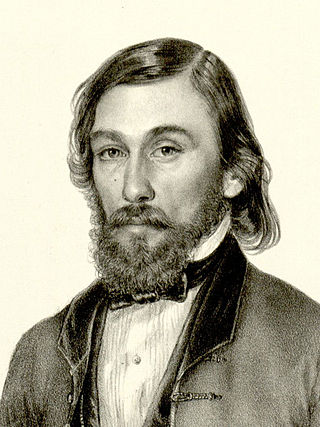Bratislava, currently the capital of Slovakia and the country's largest city, has existed for about a thousand years. Because of the city's strategic geographical location, it was an important European hub due to its proximity to the advanced cultures of the Mediterranean and the Orient as well as its link to the rest of Europe, which were possible by the Danube River.

Ludevít Štúr, also known as Ľudovít Velislav Štúr, was a Slovak revolutionary, politician, and writer. As a leader of the Slovak national revival in the 19th century, and the author of the Slovak language standard, he is lauded as one of the most important figures in Slovak history.

Trnava is a city in western Slovakia, 47 km (29 mi) to the northeast of Bratislava, on the Trnávka river. It is the capital of the Trnava Region and the Trnava District. It is the seat of a Roman Catholic archbishopric. The city has a historic center. Because of the many churches within its city walls, Trnava has often been called "Little Rome", or more recently, the "Slovak Rome".
The Slovak language is a West Slavic language. Historically, it forms a dialect continuum with Czech. The written standard is based on the work of Ľudovít Štúr, published in the 1840s and codified in July 1843 in Hlboké.

Štúrovo is a town in Slovakia, situated on the River Danube. Its population in 2018 was 10,279.

Skalica is the largest town in Skalica District in western Slovakia in the Záhorie region. Located near the Czech border, Skalica has a population of around 15,000.
Gabriela Dudeková is a Slovak historian.

Jozef Miloslav Hurban was a leader of the Slovak National Council and the Slovak Uprising in 1848–1849. He was a writer, journalist, politician, organizer of Slovak cultural life, and a Lutheran pastor. He was a supporter of Ján Kollár, and later of Ľudovít Štúr. His son, Svetozár Hurban-Vajanský, followed in his footsteps both as a writer and nationalist.

Ján Botto was a Slovak poet, writer of the Štúr generation and co-founder of the first Slovak gymnasium in Revúca.

The Slovak Uprising , Slovak Volunteer Campaigns or Slovak Revolt was an uprising of Slovaks in Western parts of Upper Hungary with the aim of equalizing Slovaks, democratizing political life and achieving social justice within the 1848–49 revolutions in the Habsburg Monarchy. It lasted from September 1848 to November 1849. In October 1848, Slovak leaders replaced their original Hungaro-federal program by Austro-federal, called for the separation of a Slovak district from the Kingdom of Hungary and for the formation of a new autonomous district within the framework of the Habsburg Monarchy.
Juraj Košút was a Hungarian nobleman, a lawyer and a supporter of the Slovak national movement.
Ladislav Deák was a prominent Slovak historian.

Ivan Kamenec is a Slovak historian.
The Blatnica-Mikulčice horizon is an early medieval archaeological horizon of metalwork. It emerged in the regions north of the Middle Danube – in present-day Czech Republic and Slovakia – following the fall of the Avar Khaganate in the early 9th century. The most featuring "Blatnica-Mikulčice" finds are swords with exquisite decorations from graves of male warriors.
Alexander Ruttkay is a Hungarian archeologist and historian. The head of the Archeological Institute of Slovak Academy of Science in Nitra in 1991–2008.

Richard Marsina was a Slovak historian, one of the founders of modern Slovak histography and a prominent expert on the medieval history of Slovakia. His scientific activities include research and publication of medieval sources, research of the oldest settlements in Slovakia, medieval towns, the history of Great Moravia, the Christianisation of Slovakia and of the Kingdom of Hungary and the oldest history of the Bishopric of Nitra. He worked in leading position at various scientific institutions like the Institute of History of the Slovak Academy of Sciences (SAS), the Slovak Society for History, the Scientific Board for Historical Sciences, Trnava University in Trnava, the Department of History at Matica slovenská and others. In the 1960s, he also worked at the research institute of SAS in Budapest, was the secretary of the Czechoslovak section of the joint Czech-Slovak-Hungarian historical commission, and the secretary of the board of experts at the commission on the sharing of cultural heritage with the Hungarian People's Republic.
Ján Stanislav was a Slovak linguist and specialist in Slavic studies.
Rudolf Krajčovič was a Slovak linguist and Slavist, the author of migration-integration theory about the origin of the Slovak language.

The Order of Ľudovít Štúr is the third highest Slovak state decoration conferred by the President of the Slovak Republic upon the proposal of the government. The president, who is a recipient, 1st Class, of the order by virtue of holding office, is not obligated to respect the proposal.









